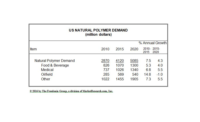U.S. demand for infection prevention products & services to exceed $27 billion
U.S. demand for infection prevention products and services is forecast to expand 4.9 percent annually to $27.6 billion in 2020. Increasing pressures on hospitals and other healthcare facilities to decrease rates of healthcare-associated infections (HAIs) will boost revenues generated by infection prevention supplies, equipment, and services. Although declining, the overall rate of certain HAIs in hospitals is significantly above targeted levels set by the CDC. Recent statistics indicate that only 25 percent of acute care facilities meet established guidelines related to the incidence of catheter-associated urinary tract and central-line-associated blood stream infections. These and other trends are presented in Infection Prevention Products & Services, a new study from The Freedonia Group (freedoniagroup.com), a Cleveland-based industry research firm.
Demand for infection prevention supplies is projected to rise 4.7 percent annually to over $21 billion in 2020. Protective apparel and textiles will continue to account for the largest share of revenues as intensified efforts by hospitals and other medical providers to hold down the incidence of HAIs in patient care promote the increasing use of higher quality, barrier-enhanced products. Waste disposal containers and accessories will post the fastest growth in demand among infection prevention supplies, spurred by the upgrading of infectious waste collection and processing sites in healthcare and life science facilities.
The market for sterilization and related equipment will rise as the healthcare and life science sectors seek to keep up with advancing infection prevention technologies and capabilities. Total demand for this equipment is expected to reach $1.1 billion in 2020, up 2.9 percent annually from 2015. The maturing of hospital, outpatient, and life science markets, coupled with the widening availability of used and retrofitted devices and systems, will moderate faster gains.
The market for infection prevention services is forecast to increase 6.1 percent annually to $5.5 billion in 2020. Infectious waste disposal services will dominate demand as government restrictions on onsite incineration remain in place, prompting health facilities to use outside firms for infectious waste collection and disposal. Although serving a more limited customer base, contract sterilization services will see favorable revenue growth. An increasing number of pharmaceutical and medical device producers will rely on outside contractors to implement sterilization processes to avoid the extensive capital investment required to set up and operate in-house systems.
Infection Prevention Products & Services (04/2016) is available from The Freedonia Group. Please email pr@freedoniagroup.com. Information may also be obtained through freedoniagroup.com.
Looking for a reprint of this article?
From high-res PDFs to custom plaques, order your copy today!




